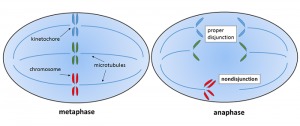Chromatid Definition
When a cell is preparing to divide, it makes a new copy of all of its DNA, so that the cell now possesses two copies of each chromosome.
The two copies of the cell’s original chromosome are called “sister chromatids.”
During anaphase of cell division, the two chromatids will be pulled apart, and chromatid will be apportioned to the cytoplasm of each daughter cell.
A “chromosome” is defined as a large amount of DNA that is physically connected into a single structure.
For that reason, while the “sister chromatids” are attached to each other, they are considered to each be one half of a single chromosome.
Once they are separated during anaphase, each chromatid is considered to be a chromosome of its own, just like the original chromosome that they are copied from.
The term “chromatid” arose as a term to distinguish each copy of the parent chromosome during the period of time before the copies become independent chromosomes themselves.
Function of Chromatids
Chromatids allow cells to store two copies of their information in preparation for cell division.
This is vital to ensure that daughter cells are healthy and fully functional, carrying a full complement of the parent cells’ DNA.
Keeping the two copies of the cells’ DNA joined together makes it easier for the cell to ensure that one copy goes to each daughter cell.
When sister chromatids fail to separate during cell division, the consequences can be severe.
Nondisjunction Errors
When sister chromosomes don’t separate properly during cell division, the result is that one daughter cell gets an extra copy of a chromosome, while the other lacks a copy completely.
Nondisjunction errors can lead to the deaths of daughter cells, which may lack essential genes to survive, or have gene balance problems due to having too many copies of the same gene to express.
Nondisjunction errors are even thought to play a role in cancer. Though different types of cancers have different causes, nondisjunction errors are thought to be one of many ways that a cell’s “programming” can become disrupted, leading it to run amok as a cancer cell.
The image below shows the proper disjunction of sister chromatids, as well as a pair of chromatids that are experiencing a nondisjunction error:
Related Biology Terms
- Chromosome – A large unit used by cells to organize and store their DNA. Prokaryotes generally have only one chromosome, while eukaryotic cells may organize their complex genomes into many chromosomes.
- DNA – The “blueprint” or “programming code” for a cell, DNA contains all the information needed to create a cell’s proteins, lipids, sugars, and to direct the stages of the cells’ lifestyle.
- Mitosis – The process through which eukaryotic cells reproduce by splitting in two.
Quiz
1. Which of the following is NOT true of sister chromatids?
A. They are produced during the S phase of the cell cycle, when the cell’s DNA is copied to prepare for cell division.
B. Sister chromatids contain identical genetic information.
C. Sister chromatids can also be referred to as chromosomes.
D. Sister chromatids become chromosomes when they are separated.
2. Which of the following is NOT a function of sister chromatids?
A. They allow cells to store two copies of their DNA while the cell prepares to divide.
B. They help to ensure that both daughter cells get a copy of each of the parent cells’ chromosomes.
C. They cross over to produce new genetic diversity in the daughter cells.
D. None of the above.
3. Which of the following is NOT a possible consequence of sister chromatids failing to separate during mitosis?
A. Death of one or both daughter cells.
B. Dysfunction in one or both daughter cells, due to missing or excess genes.
C. Increased likelihood of the development of cancer due to multiple gene dysfunctions.
D. None of the above.

